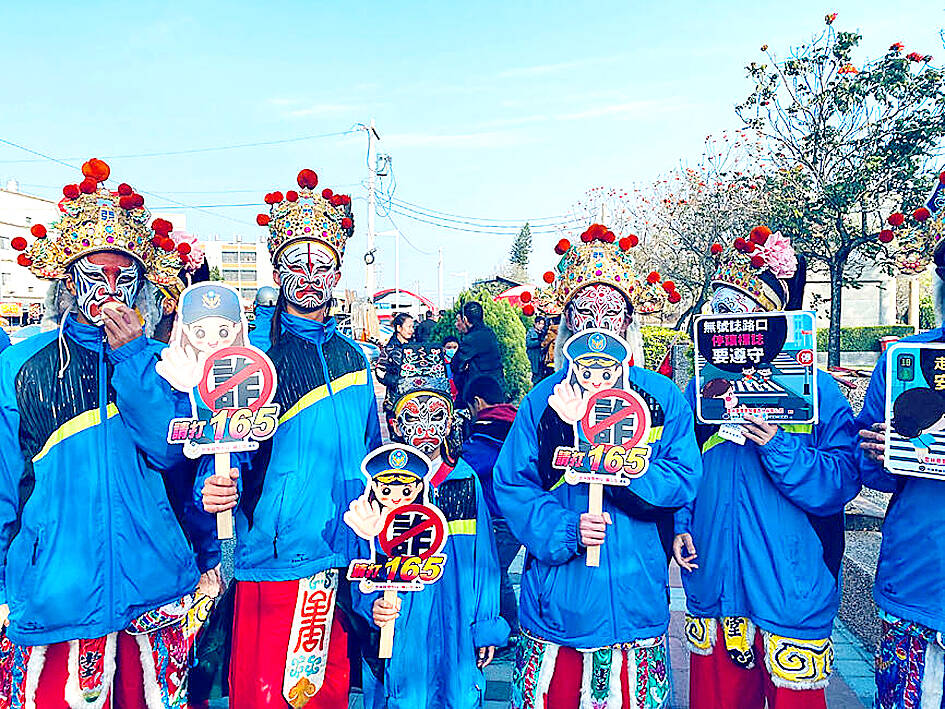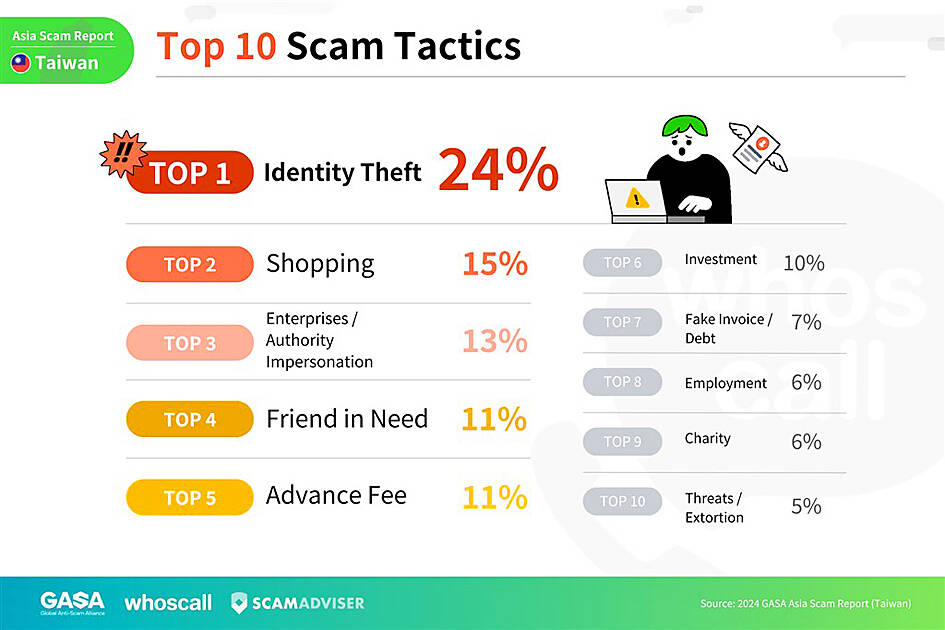People in Taiwan might have lost as much as NT$239.5 billion (US$7.52 billion) to scams over the past 12 months, an anti-scam research report released on Monday showed, based on a survey of people in East, Southeast and South Asia.
The total losses to scams in Taiwan ranked fourth behind those in South Korea, Singapore and Japan, a survey of 13 countries and territories conducted jointly by the Global Anti-Scam Alliance, Gogolook and ScamAdviser, a Web site legitimacy checker, showed.
The total losses in Taiwan was estimated proportionally from a survey of 5,003 Taiwanese, who each lost an average of US$1,940 to scammers, amounting to 1 percent of Taiwan’s GDP last year.

Photo courtesy of the Yunlin County Police Department
The survey, which collated responses from about 25,000 respondents over three-day periods in June and July, was also conducted in China, Hong Kong, India, Indonesia, Malaysia, Pakistan, the Philippines, Thailand and Vietnam, said Kara Yang (楊莞儀), a PR staffer at Whoscall, an app developed by Gogolook.
The US$1,940 loss per capita represented a 67.7 percent increase from the previous year, second only to South Korea, where individual scam losses nearly doubled from US$1,384 to US$2,738 during the same period, Yang said.
Only 2.74 percent of Taiwanese — the lowest of any group of respondents — said they would be willing to accept an offer to receive US$20,000 on the condition that they send US$19,000 to another bank account and keep the remaining US$1,000, the survey showed.

In contrast, 20.8 percent of Indians would consider participating in such a scheme, the highest in Asia.
While only 17 percent of Taiwanese respondents said they were “not confident at all” in their ability to recognize scams, the share of those who felt “confident” or “very confident” dipped to 55 percent, down 5 percentage points from the previous year.
Whether that decline was caused by the growing use of artificial intelligence (AI) was not specified, but at least 65 percent of respondents said they were aware of the use of AI in scams such as generating dialogues, mimicking voices or creating images and videos.
Meanwhile, phone calls and social media posts have overtaken text/SMS messages as the most common scam delivery methods, with social media scams ballooning to 55 percent, an increase of 21 percent from last year.
Among all social media platforms, Facebook had the highest rate of exposure to scams (63 percent) for two years in a row, where scam tactics primarily involve fake investment experts or analysts luring victims to invest in or purchase fraudulent financial products.
The most common type of scam in Taiwan was identity theft, with 24 percent of victims having experienced it, the survey showed.
The primary way of paying scammers was through bank transfers at 39 percent, the survey showed.
Only 6 percent of Taiwanese have gotten their money back after being scammed, the survey showed.
Meanwhile nearly 30 percent said they would not report being scammed because the procedures were too complicated and they did not believe it would help even if they did report it.
An initial version of the study was released based on countries and areas, Yang said, with a more comprehensive version set to be published later this month.

‘DANGEROUS GAME’: Legislative Yuan budget cuts have already become a point of discussion for Democrats and Republicans in Washington, Elbridge Colby said Taiwan’s fall to China “would be a disaster for American interests” and Taipei must raise defense spending to deter Beijing, US President Donald Trump’s pick to lead Pentagon policy, Elbridge Colby, said on Tuesday during his US Senate confirmation hearing. The nominee for US undersecretary of defense for policy told the Armed Services Committee that Washington needs to motivate Taiwan to avoid a conflict with China and that he is “profoundly disturbed” about its perceived reluctance to raise defense spending closer to 10 percent of GDP. Colby, a China hawk who also served in the Pentagon in Trump’s first team,

SEPARATE: The MAC rebutted Beijing’s claim that Taiwan is China’s province, asserting that UN Resolution 2758 neither mentions Taiwan nor grants the PRC authority over it The “status quo” of democratic Taiwan and autocratic China not belonging to each other has long been recognized by the international community, the Mainland Affairs Council (MAC) said yesterday in its rebuttal of Beijing’s claim that Taiwan can only be represented in the UN as “Taiwan, Province of China.” Chinese Minister of Foreign Affairs Wang Yi (王毅) yesterday at a news conference of the third session at the 14th National People’s Congress said that Taiwan can only be referred to as “Taiwan, Province of China” at the UN. Taiwan is an inseparable part of Chinese territory, which is not only history but

CROSSED A LINE: While entertainers working in China have made pro-China statements before, this time it seriously affected the nation’s security and interests, a source said The Mainland Affairs Council (MAC) late on Saturday night condemned the comments of Taiwanese entertainers who reposted Chinese statements denigrating Taiwan’s sovereignty. The nation’s cross-strait affairs authority issued the statement after several Taiwanese entertainers, including Patty Hou (侯佩岑), Ouyang Nana (歐陽娜娜) and Michelle Chen (陳妍希), on Friday and Saturday shared on their respective Sina Weibo (微博) accounts a post by state broadcaster China Central Television. The post showed an image of a map of Taiwan along with the five stars of the Chinese flag, and the message: “Taiwan is never a country. It never was and never will be.” The post followed remarks

INVESTMENT WATCH: The US activity would not affect the firm’s investment in Taiwan, where 11 production lines would likely be completed this year, C.C. Wei said Investments by Taiwan Semiconductor Manufacturing Co (TSMC, 台積電) in the US should not be a cause for concern, but rather seen as the moment that the company and Taiwan stepped into the global spotlight, President William Lai (賴清德) told a news conference at the Presidential Office in Taipei yesterday alongside TSMC chairman and chief executive officer C.C. Wei (魏哲家). Wei and US President Donald Trump in Washington on Monday announced plans to invest US$100 billion in the US to build three advanced foundries, two packaging plants, and a research and development center, after Trump threatened to slap tariffs on chips made